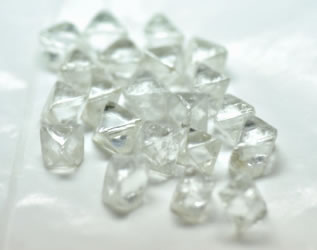Diamond producers have been for some time now struggling to find new, large deposits to replace their aging assets.
With supplies of easy to get gems (alluvial) facing depletion there has been need for miners to go underground, which unfortunately was capital intensive.
The other option was to hunt for new operations that can reverse the downward trajectory in reserves.
Angola, which lies behind Russia and Canada in unexplored diamond potential in the world, had of late proved to be one such country where big players in the industry are pinning their faith of finding new mines in.
It also seems as if Angola was aware of that, as it recently put peanut butter on the mouse trap to ensnare big mouse (reads miners) in the form of lower taxes.
“The new law is very clear with lots of security for investors, which gives them certainty, transparency and guaranteed mining rights,” Geology and Mines Minister Francisco Queiroz was quoted by Bloomberg as saying.
“It has flexibility for companies to join with partners based on negotiation with the government, not imposition, which is a break from the past.”
It should be stated that the move was not only aimed at promoting diamond mining, rather it also seeks to boost investment in other minerals such as iron ore and gold.
So, with the mine taxes reduced and the country said to be one of the top three unexplored countries, as far as diamonds are concerned, it was now clear why De Beers and Alrosa were making moves on the country.
Bloomberg reported earlier in the year that De Beers was confident of finding a gem deposit in Angola that would allow it to recover the $250 million it spent on exploration in the country since 2005.
It explored five concessions in the country during this period.
De Beers, according to the report, had found diamonds in a 3,000 square-kilometer concession near Lucapa in the Lunda North province.
“We are confident we can find something that will allow us to recover all our investment,” said company business manager in Angola Pedro Lago de Carvalho. “The contract is clear, there is no debate.”
The results of evaluation studies of three kimberlites at Mulepe were expected soon and would be followed by meetings with Endiama to decide the way forward.

De Beers had a 49 percent share in the Mulepe concession, with Endiama holding the rest.
De Carvalho said Angola was a “high priority” for De Beers and prove that an annual budget of $30 million had been set aside for prospecting.
On the other hand, the Russian diamond monopoly Alrosa said that there was a high probability of discovering new large primary diamond deposits in Angola.
Alrosa’s geologists would conduct preliminary work to assess the most promising areas in terms of primary diamond deposits.
The visit to Angola recently by Alrosa’s president Fyodor Andreev was also testament of how the diamond giant treats seriously prospects of starting new mines in the southern African country.
Andreev met with President José Eduardo dos Santos, along with the country’s mining minister, Francisco Queiróz, and the management of ENDIAMA and Sociedade Mineira de Catoca.
Alrosa and Endiama each own 32.8 percent of the Catoca mine.
The Russian diamond monopoly said that the parties discussed the prospect of an exploration joint venture with Endiama.
“The geological material already produced by Alrosa’s specialists in Angola proves there is a high probability to discover new large primary diamond deposits in this country,” a company spokesperson was quoted as saying by Rapaport.
Other sources claimed that Alrosa had previously discussed the possibility of acquiring venture prospecting licences in areas of Quang and Luminash.
Apart from the areas targeted by De Beers and Alrosa, state-owned company diamond miner Endiama said last March that it would likely start production at four new diamond mines within a year.
Bloomberg quoted Endiama spokesperson Antonio Freitas as saying that these included two kimberlite mines in Tchiuzo, Lunda Sul province and Chiri in Lunda Norte province.
These would start end of the year or early 2014.
The Tchiuzo operation, he said, would be operated by Sociedade Mineira de Catoca, a company owned by Endiama together with OAO Alrosa of Russia and Odebrecht SA of Brazil.
Freitas said the other two, were alluvial mines and would be expected to commence production this year.
These were Tchege in Lunda Sul and Maua in Malanje province near the border with the Democratic Republic of Congo, Bloomberg reports.
Escom Investimentos e Participacoes SA, an Angolan company with interests from mining to property, also planned to start output from a diamond deposit in May.
[two_third]
Company president Helder Bataglia said the Tchegi alluvial site would produce, together with Escom’s existing Luo kimberlite mine, a total of about 35,000 carats a month by the end of the year.
Chances are high that Angola would go up the ranks of world diamond mining once all these projects go on full throttle.
Production was this year expected to reach between 9 million and 10 million carats from just over 8 million carats recorded last year.
In a nutshell, De Beers and Alrosa had demonstrated that they were not willing to remain behind in the Angolan diamond boom.
[/two_third]
[one_third_last]
“Production in Angola was this year expected to reach between 9 million and 10 million carats from just over 8 million carats recorded last year.”
[/one_third_last]
Interestingly, they are not closing their eyes either on opportunities in Zimbabwe and Botswana, although De Beers might have problems in the former given their bad blood with Harare over Marange diamonds.

